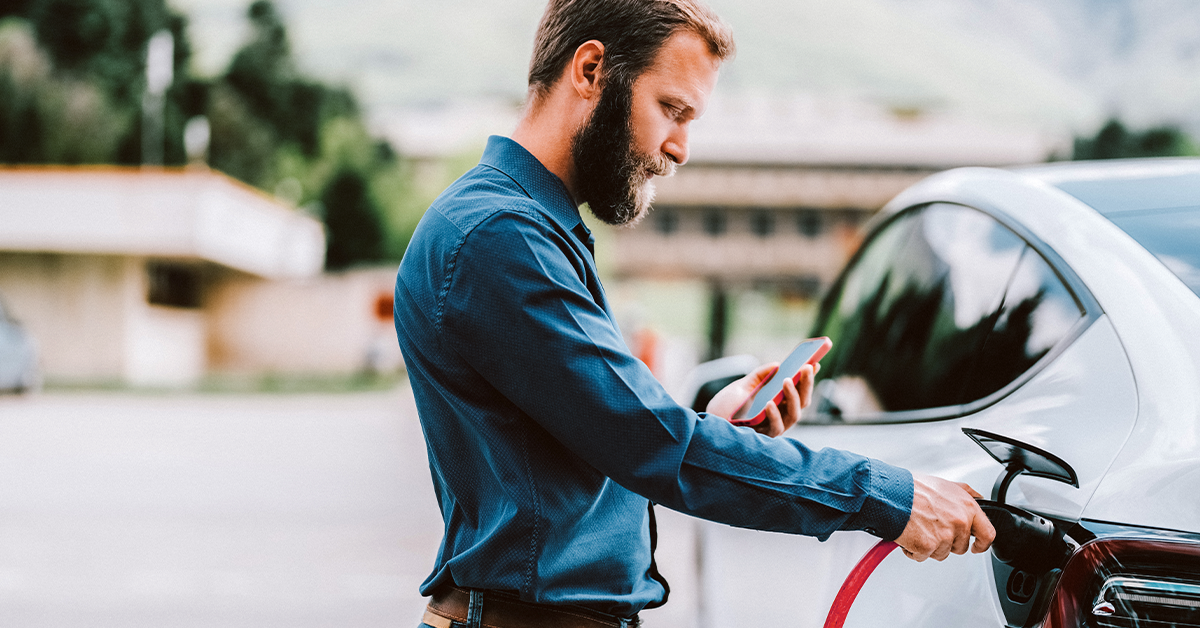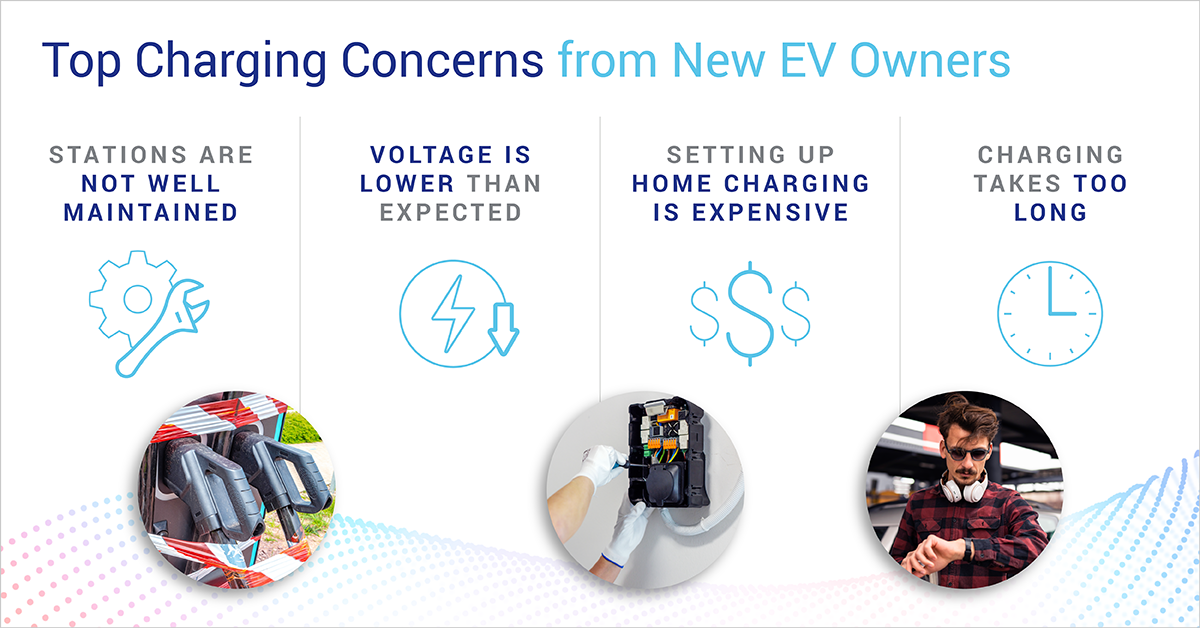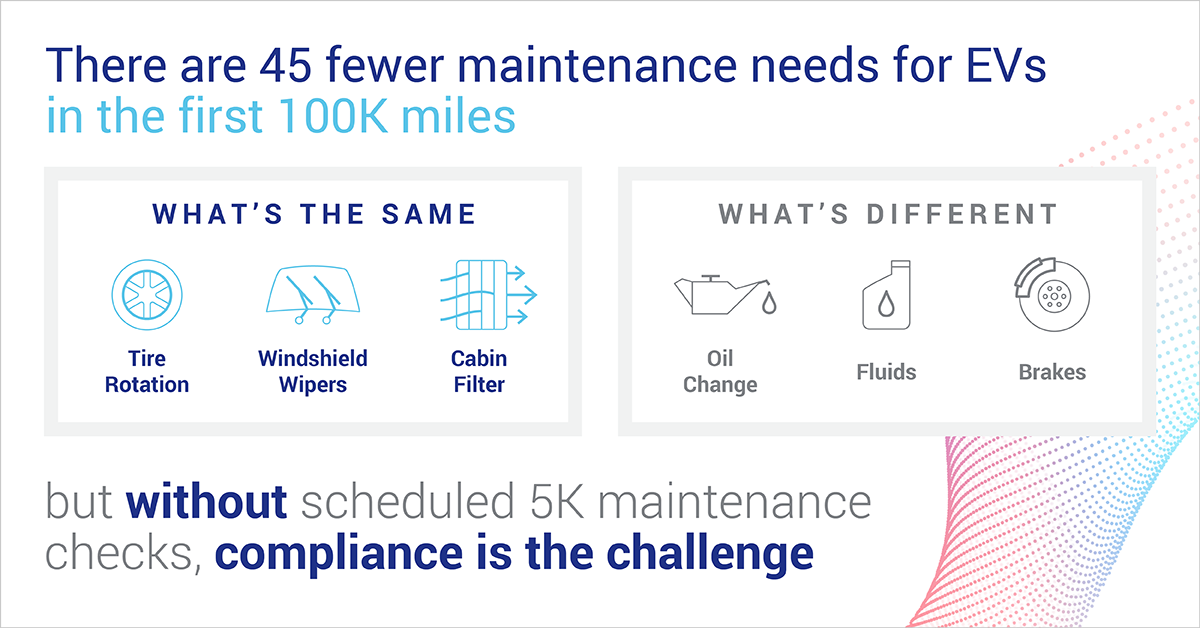Agero Insights

After the initial charge: The Post Purchase Experience for EV Drivers
December 18, 2023 | 7 min read
From gas station protocol to when to get an oil change, the majority of today’s drivers have learned the basics of how to maintain and operate vehicles through the lens of internal combustible engines. And while there have certainly been major updates and changes throughout the years (from tapes to CDs to ApplePlay), the rules of maintaining and operating a regular car across makes and models has remained pretty consistent. Then came the electric vehicle.
While the look and feel of an electric vehicle (EV) can be similar to its gas counterpart, operating and maintaining one is, of course, quite different. In fact, a majority of consumers are unaware of just how different the nuances of EV ownership are until they decide to purchase one. To get a better understanding of the disruptions that EV drivers face, we did extensive interviews with new EV owners to learn more about their expectations vs. reality. Here are some of the highlights:
Is this thing on? From the basics to the complex, there's lots for new EV owners to learn.
New EV drivers commented that there was a lot to learn–and more than they expected that would have to be self-taught. This included the basics–such as how to turn the car on and off. As many EV interiors are now streamlined and operated by a touchscreen, the physical and tactical gadgetry that gas powered drivers are used to (such as key ignitions or power buttons for the radio or A/C) have been removed.
It also included the more complex–such as how to keep the car’s battery in optimal condition under different traveling needs. There was also quite a bit of uncertainty with regard to what maintenance was required and when.
When we asked these new EV drivers what sources they utilized to educate themselves about these issues, the vast majority consulted a friend or family member with an EV, followed by YouTube. Many stated that they would have liked (and should have received) more support from their dealership.

Customers assume that less maintenance is needed for EVs but there is a lack of understanding about what is needed and when.
When it comes to maintenance, most new owners expressed uncertainty about what was needed. Most understood that there was no need for an oil change but they weren’t sure what was needed. In addition, there was a lot of inconsistency as to when checkups were needed. One driver noted that this owner's manual said 8K and the vehicle’s automated notifications which went off after 5K. Others were unsure when maintenance was needed and hoped that the vehicle would update them.
For drivers that complied with the recommended maintenance, there was some frustration because they weren’t clear on what was actually included. He noted, “I paid $800 for a 10K checkup. I think they changed the wipers.”
Drivers seemed to recognize that things like tires required regular maintenance. Tire maintenance is especially critical when it comes to EVs because the vast majority do not have a spare tire, which complicates a flat tire event. However, many of the drivers in our survey were unaware that their vehicle did not have a spare.
Driver education on EV maintenance will help reduce this confusion and improve compliance. Most expected to do maintenance at the dealership so this is a nice opportunity to connect with EV drivers.
For owners, it is less about range anxiety and more about range disappointment.
The next big topic was range. We hear a lot about range anxiety and fear of running out of charge when it comes to purchasing new EVs. In fact, nearly 50% of people considering an EV purchase raise charge as a barrier according to the most recent Agero Consumer Benchmark. However, for owners, this accounts for less than 2% of roadside events based on 2023 Agero event data. This indicates that EV owners aren’t actually experiencing issues with charging capacity. In fact, the larger issue we uncovered from new EV owners we spoke with was misalignment of expectations on vehicle range.
Many customers were surprised at the large discrepancy between their EV’s quoted range and the actual range they received when driving. A few even considered returning their vehicle as a result. EV battery range is impacted by speed, lighting, radio, A/C, and other accessories that draw power. One EV owner shared that they expected 360 miles per charge, but only typically received around 280. Weather also plays a significant role–specifically in the colder months. Another owner shared that their vehicle range dropped by more than 50% in winter compared to summer.

When it comes to charging, there’s a lot to learn and a few unpleasant surprises: cost, time, complexity.
Charging an EV may seem simplistic and straightforward; however, there’s more to it than meets the eye (or electrical socket).
CHARGING AT HOME
Many customers are unaware of the costs and options associated with charging at home. If they don’t drive often, using a mobile charger that plugs into a regular outlet could suffice, even though charging would be drastically slower. Alternatively, for those who drive quite often, installing a Level 2 charger to boost charging power and speed would be necessary.
The latter option typically requires hiring a professional, and the age, location, and infrastructure of the home will determine how much detailed electrical work needs to be performed, which can cost a pretty penny. The charger itself ranges from $300-$1200, and electrical requirements can run as much as $15K. In addition, this process can take months due to inspections and local agency requirements.
"We started our process of installing a Level 2 charger 4 months ago in southern california - we needed to upgrade the panel for our 1965 home and trench our concrete driveway in order to be ready for installation. We still have 3 months of approvals and process stages before we'll be able to charge our car in our own driveway."

PUBLIC CHARGING STATIONS
For customers charging at public charging stations - there are other challenges. First - there’s the apps. Lots of them. Unfortunately, there is no one size fits all; every charging network has its own app that needs to be downloaded and configured separately. And while many OEMs offer a charging benefit with purchase, this can only be leveraged if the OEM app is set up correctly, which can be difficult and confusing to do. This was a source of frustration for a few new owners we spoke with.
Once you’ve got the where sorted out - there’s the how. Customers charging at a public charging station for the first time are unaware of etiquette and protocol. Where does the line form and how do you know who is next? One new owner told us that she knocked on the windows of all the cars nearby to figure out her place in line. Others expressed concerns about safety in remote or unattended charging stations.
Lastly, owners mentioned that operability posed unexpected barriers. They noted that chargers at public stations are often down, or charging at significantly lower voltage than expected. While charging networks advertise 350kw, many top out at 110kW.
HOW MUCH TO CHARGE
Many manufacturers recommend keeping the battery between 20% to 80% in order to avoid battery degradation over time. Some owners we spoke with abided by this requirement diligently, but not all. Charging levels of course vary by each person’s individual traveling needs, which not only include distance, but weather conditions and the availability of charging stations along their destination.
CHARGING TIME
Lastly, how long is charging going to take? In addition to how low your EV’s battery is, charging time is also affected by whether or not your EV has a battery priming feature. For some models, if you use the car GPS to go to the charging station, the car will prime the battery for charging. For these same models, if you use a GPS on your phone, or just drive to the charging station without utilizing the GPS, the car will not be notified of your plans to charge and therefore will not prime the battery beforehand.
Many customers were unaware of whether or not their vehicle had a battery priming feature. Without this battery prep, charging can be slower. In addition, there is a wide range in voltage, from 50 kW to 400 kW. The new owners we spoke with commented that the voltage was consistently lower than expected, which led to lengthy charging sessions. One owner shared that it took 6+ hours!
It’s time to evolve with the EV revolution.
Regardless of everything that was different or surprising about electric vehicles, the dozen EV owners we spoke with were nonetheless excited to be part of the EV revolution and would still recommend their vehicles to family and friends. Many also commented that while the environmental and savings benefits were a plus, most purchased these vehicles because “it was just an awesome car.”
That being said, if we are looking to provide support for the EV revolution, we must first and foremost recognize that the battlecry from EV owners is overwhelming: there needs to be more solid, reliable resources for seamless onboarding. The learning curve in transitioning from gas to electric is too wide a gap to be ignored. Different vehicles need different kinds of support, and innovative new services such as mobile charging, tire on demand and digital fix will not only strengthen relationships with customers and build better brand affinity, but also help align EV expectations with reality.
To learn more about the services and support that Agero can provide to you and your customers with their EVs, click here.
Meet the Author: Shana Cooper - Senior Director, Product Marketing
 Shana Cooper leads the Product Marketing team at Agero. She joined the team in 2019 and has helped build and shape product content and education across all lines of business. Prior to Agero, Shana worked in a range of early stage start-ups covering everything from robots to biotech to IoT consumer products. She loves the challenge of helping to understand and communicate complex products. Shana has a BA in Chemistry from Colgate University and an MBA from Boston University.
Shana Cooper leads the Product Marketing team at Agero. She joined the team in 2019 and has helped build and shape product content and education across all lines of business. Prior to Agero, Shana worked in a range of early stage start-ups covering everything from robots to biotech to IoT consumer products. She loves the challenge of helping to understand and communicate complex products. Shana has a BA in Chemistry from Colgate University and an MBA from Boston University.Recent Posts
Auto Industry Leader Tom Feeney Joins Agero’s Board of Advisors
Former Safelite president and CEO to guide Agero’s strategy across technology innovation and...Agero’s Earns Sixth Straight Best Places to Work Award
Annual award honors leading organizations for outstanding workplace culture, employee benefits, and...Agero’s Bob Sullivan Wins 2025 National ORBIE® Award
Recognition marks third consecutive year the esteemed award program has honored Sullivan as an...

